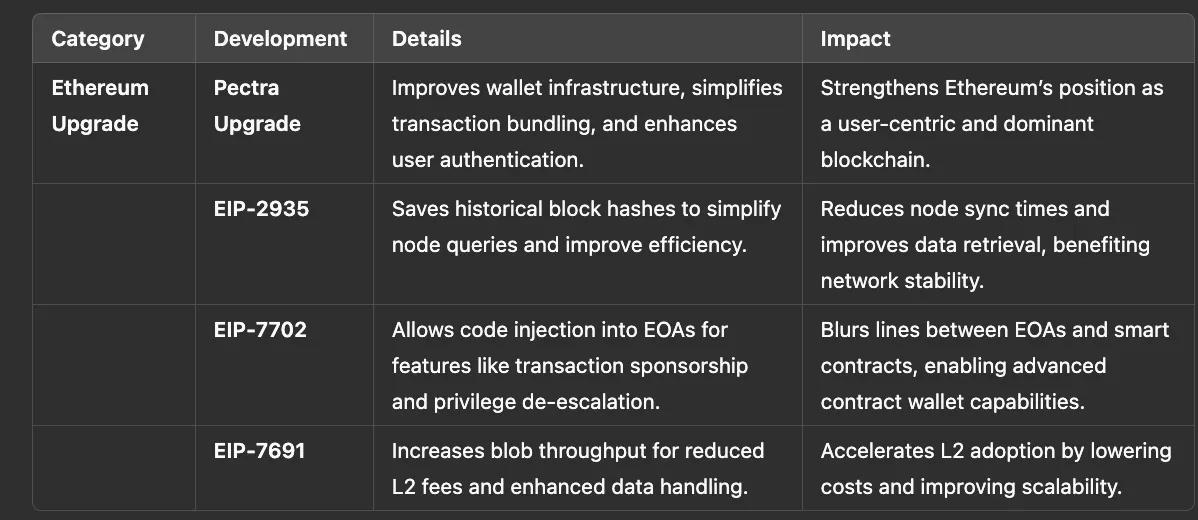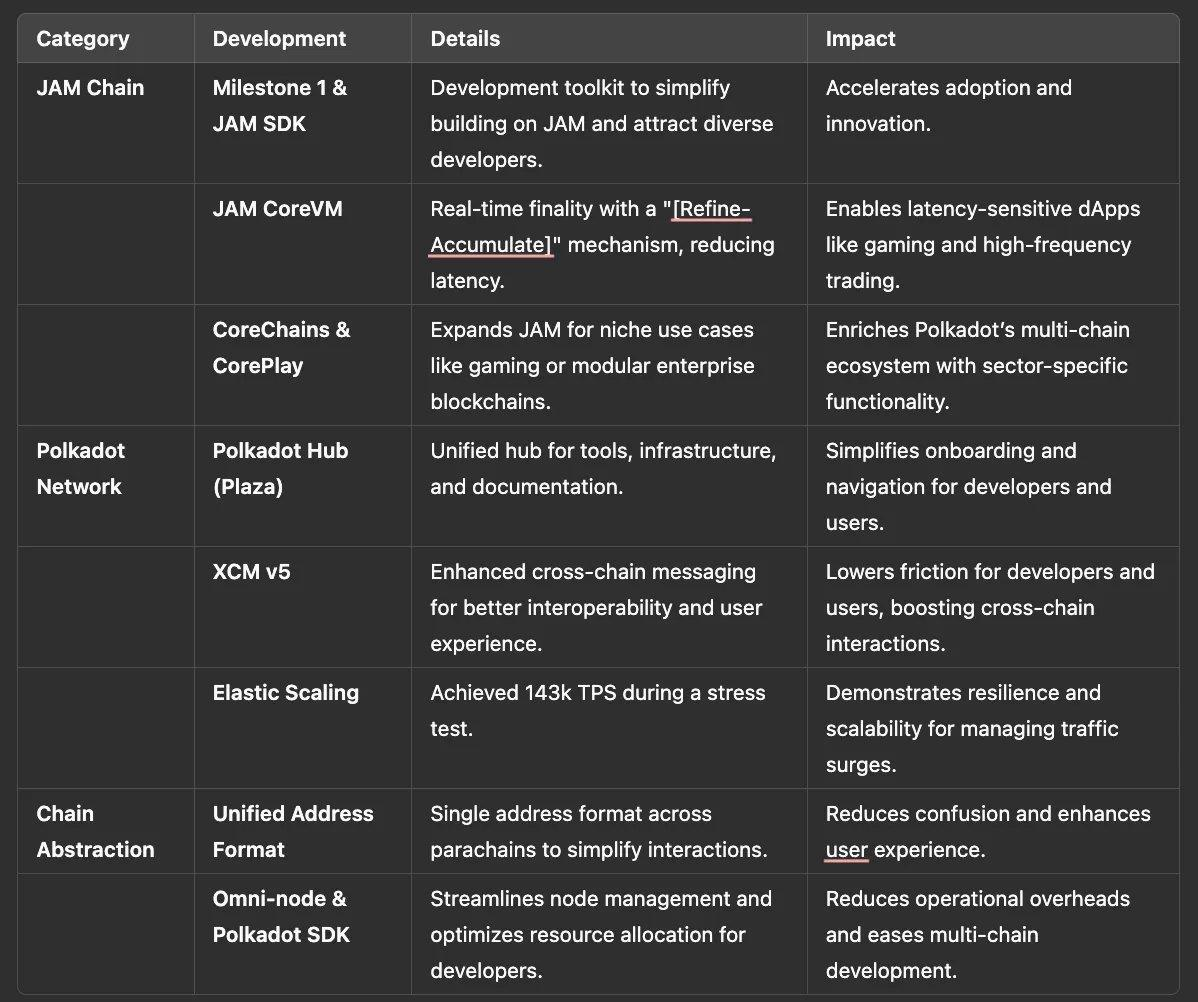What key developments in the Ethereum and Polkadot ecosystem are worth paying attention to in 2025?

Reprinted from panewslab
01/15/2025·23days agoAuthor: Techub Selected Compilation
Written by: arndxt
Compiled by: Glendon, Techub News
As 2024 ends and 2025 begins, I look back on my cryptocurrency journey and glean some insights from OpenGuild Vietnam and the discussions surrounding Ethereum and Optimism Superchain.
Based on this, I will explore the key technology and strategic development trends that will have a significant impact on the Ethereum and Polkadot ecosystem in 2025.
Cryptocurrency Market Overview
Currently, the entire market is facing regulatory and technological changes, especially in Vietnam and the intersection of artificial intelligence (AI) and cryptocurrency.
Vietnam legalizes cryptocurrency
The Vietnamese government plans to complete the formulation of a legal framework for cryptocurrency by May 2024, a move that may herald the emergence of a new wave of legal cryptocurrency businesses.
Regulatory clarity reduces uncertainty, thereby attracting the attention of more high-quality projects and institutions. If the framework is designed correctly, Vietnam could become a hub for blockchain startups, connecting Southeast Asia’s booming tech ecosystem with the global cryptocurrency market.
Stablecoins and user adoption
At present, the use of stablecoins has grown significantly and shows the potential for continued growth. Behind it, the growing stablecoin infrastructure may drive wider adoption, especially in regions with volatile local currencies.
At the same time, stablecoins serve as one of the most powerful gateway use cases in cryptocurrencies. By providing a secure medium of exchange, they facilitate daily transactions and enable value protection when local currencies fluctuate. Continuing improvements, such as more efficient on/off channels, may further integrate stablecoins into the global financial system.
AI agent ecosystem
The rise of AI x cryptocurrency solutions has been the focus of investors and incubators such as Y Combinator since late 2024.
An ecosystem of AI agents (e.g., fully autonomous trading bots, decentralized AI modules, on-chain AI oracles) promises to simplify tasks that traditionally require human intervention. However, as these systems mature, they may raise legal and technical questions about governance, liability, and data privacy.
Proof of character
The convergence of artificial intelligence and cryptocurrency naturally raises concerns about identity verification, especially with the proliferation of deepfakes and AI-generated avatars. Proof of Personhood is a decentralized identity-based solution that ensures independent human identity verification.
If AI can simulate human behavior on-chain, then strong authentication mechanisms will become even more important. Therefore, proof-of-personhood mechanisms could become a standard for social applications, membership in decentralized autonomous organizations (DAOs), or token airdrops. Expect more innovation in cryptographic methods, such as zero-knowledge proofs, to protect user privacy while verifying authenticity.
Ethereum Ecosystem
Ethereum's evolution in 2025 will focus on chain abstraction and protocol-level upgrades to enhance network efficiency, L2 throughput, and user experience.

Pectra upgrade
Ethereum’s Pectra upgrade is undoubtedly a landmark event that focuses on improving wallet infrastructure and solving broader ecosystem challenges. With chain abstraction becoming a key priority for various blockchain platforms, the successful implementation of the Pectra upgrade has the potential to redefine how users interact with Ethereum.
In my opinion, the Ethereum mainnet is at a crossroads. The rise of powerful L2s such as Optimism, Arbitrum, and zkSync has intensified the pressure to maintain Ethereum's status as the "gold standard." Pectra has the potential to bridge key gaps and simplify the wallet experience by solving pain points such as high gas fees, transaction bundling and user authentication. If implemented effectively, it could significantly boost user engagement while solidifying Ethereum’s dominance in an increasingly competitive ecosystem. To me, this is Ethereum doubling down on user-centric innovation, a move that secures its place in the blockchain hierarchy.
EIPs to watch in 2025
Important Ethereum Improvement Proposals (EIPs) in 2025 include EIP-2935, EIP-7702 and EIP-7691.
- EIP-2935: Save historical block hashes in state
Storing block hashes for a definable period of time simplifies node verification queries for blocks, increasing efficiency and reducing overhead.
Analysis: This is a "network pipe" improvement that, while unspectacular, is of great significance to node operators. Improved data retrieval can also help reduce chain reorganization and node synchronization time.
- EIP-7702: Set EOA account code for a single transaction
The proposal extends the functionality of Externally Owned Accounts (EOA) by allowing code injection using specialized transaction types. As well as unlocking features such as batch processing, sponsorship (paying gas for others), and permission downgrade (lowering permissions without changing the address).
Analysis: This proposal may blur the lines between EOA and smart contracts, thereby promoting the development of more complex contract wallets (such as ERC-4337-based solutions). If widely adopted, it could catalyze user-friendly features such as transaction sponsorship or advanced multi-signature solutions.
EIP-7691: Improve blob throughput
Based on EIP-4844 (Proto-Danksharding) that introduced "Blobs" to reduce L2 costs, this EIP increases the number of Blobs in each block, thereby further reducing L2 costs and improving throughput.
Analysis: The synergy between L1 and L2 scaling is very important for Ethereum. By scaling Blob capacity, Ethereum reaffirms its commitment to maintaining an affordable L2 environment. If L2 can handle more data without incurring high costs, user adoption of second-tier solutions may accelerate.
Polkadot Ecosystem
To this day, Polkadot remains a hotbed for cross-chain experimentation. Some important developments in 2025 aim to solidify Polkadot's position as an infrastructure for interoperability and high-throughput decentralized applications.

JAM Chain and its innovations
As a high-profile next-generation blockchain protocol in the Polkadot ecosystem, JAM Chain is currently attracting widespread attention. If successful, JAM could demonstrate Polkadot's commitment to a plug-and-play multi-chain architecture.
Milestone 1 and JAM SDK
An important sign for the JAM team is the completion of "JAM Milestone 1", which includes the launch of a development toolkit called JAM SDK. The toolkit can simplify building applications on JAM and may appeal to a wider range of developer types (from traditional backend engineers to professional blockchain developers).
JAM CoreVM
The introduction of JAM CoreVM has the potential to redefine how real-time transactions and application execution are handled. By replacing the traditional block finalization method with a Refine-Accumulate mechanism, JAM CoreVM will provide near real-time finality.
This approach can significantly reduce latency, a long-standing challenge that blockchains face in their pursuit of fast confirmations without sacrificing security. If executed well, it could encourage more latency-sensitive DApps (such as high-frequency trading, real-time gaming, or event-driven DeFi) to migrate to or launch on JAM-powered Polkadot’s parachains.
CoreChains and CorePlay
After completing the virtual machine layer construction, the JAM team plans to expand functionality through CoreChains and CorePlay. Although the specific details currently disclosed are limited, these solutions appear to expand the application boundaries of the JAM architecture, especially targeting gaming ecosystems or specific niche scenarios that are critical to the modular design of enterprise-level blockchains.
The core idea of Polkadot is built around specialized parachains. JAM's approach to building CoreChains illustrates an underlying trend toward industry-specific functionality. If these specialized parachains each solve unique challenges (such as compliance, gaming, or data management), then they will greatly enrich Polkadot's value proposition as a multi-chain network.
Comprehensive improvements to the Polkadot network
In addition to JAM’s initiatives, Polkadot itself will receive significant upgrades to reflect the lessons learned from network stress testing and community feedback over the past year.
Polkadot Hub (Plaza)
The completion of Polkadot Hub (Plaza) focuses on integrating ecosystem tools, infrastructure, and documentation.
Analysis: As the ecosystem expands, a unified hub makes sense for both new and experienced developers. Focusing resources can significantly reduce complexity, which is an important step for Polkadot to attract more developers and end users amid fierce competition with other L1 and L2.
XCM v5
Cross-chain messaging (XCM) is key to Polkadot’s interoperability vision. XCM v5 will improve and upgrade cross-chain messaging, enhance interoperability, and achieve more efficient, secure cross-chain communication and a better user experience.
Analysis: Cross-chain operability remains the holy grail of the cryptocurrency space. While existing solutions such as Wormhole and LayerZero help connect the ecosystem, XCM serves as a dedicated tool for Polkadot. Making XCM more efficient and secure can make cross-parachain operations more "native," potentially reducing friction between users and developers.
Elastic expansion
After Kusama suffered a severe spam attack in December 2024, Polkadot's Elastic Scaling mechanism demonstrated its adaptability under high load and could handle 143k TPS.
Analysis: It is extremely critical for a chain to have the ability to effectively respond to sudden traffic surges. Successfully defending against spam attacks can strengthen its marketing efforts and demonstrate the resilience and reliability of its chain. However, the more serious test is how to manage the dramatic growth of legitimate traffic, especially when Polkadot-based DApps gain widespread attention and usage.
Chain Abstraction and Omni-Network Development
Polkadot’s overall strategy is increasingly focused on making the network more developer and user-friendly, while ensuring that the complexity of the underlying technology remains hidden behind the scenes.
Unified address format
Polkadot aims to eliminate the confusion caused by multiple wallet standards by introducing a single address format for parachains.
Although simplifying addresses is not an easy task, this move is a key step to reduce cross-chain interaction barriers and improve user experience. This is similar to Apple's iOS ecosystem, which enhances consistency across multiple apps and services by unifying the user experience.
Omni-node and Polkadot SDK
Maintaining up-to-date node software for dozens of parachains requires significant resources. Omni-node aims to simplify this process by optimizing resource allocation.
From a developer's perspective, initiatives to reduce operational overhead are undoubtedly welcome. However, the complexity of Polkadot's multi-chain approach may require continued improvements in developer tools, so in addition to Omni-node, you can also expect iterative enhancements to other tools.
final thoughts
As mentioned earlier, Ethereum will continue to iterate through the Pectra Upgrade and Improvement Proposal (EIP) to solidify its L1 position as a reliable settlement layer for the booming L2 ecosystem. Polkadot uses innovations such as JAM Chain, Omni-node, and improved XCM to optimize cross-chain usage and expansion.
In addition, broader market trends, including regulatory initiatives in Vietnam, stablecoin improvements and AI-powered crypto proxy systems, highlight the rapidly evolving nature of the crypto space. So, what will the crypto space look like in 2025? Let us wait and see!


 chaincatcher
chaincatcher